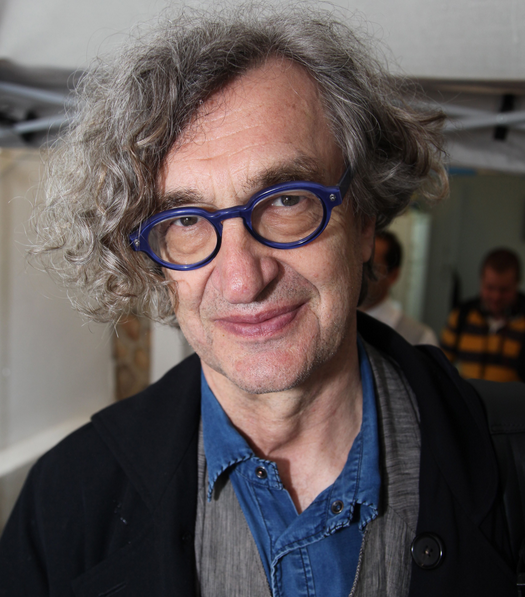Interview: Wim Wenders on Every Thing Will Be Fine, 3D and Guilt
 Friday, December 18, 2015 at 8:00AM
Friday, December 18, 2015 at 8:00AM  Director Wim WendersThis interview was conducted by guest contributor Amir Ganjavie, during the 2015 Toronto International Film Festival. Every Thing Will Be Fine was released in theatres last week.
Director Wim WendersThis interview was conducted by guest contributor Amir Ganjavie, during the 2015 Toronto International Film Festival. Every Thing Will Be Fine was released in theatres last week.
Four years after his success with 3D in the dance film Pina, Wim Wenders is using the technology in the realm of fiction filmmaking in Every Thing Will Be Fine. One of the German auteur’s most accessible films, this psychological thriller is about the traumatic experiences of Tomas (James Franco), a writer who is dealing with the consequences of a brutal car accident. The effects of this tragedy on him and on Kate (Charlotte Gainsbourg), who has lost someone close, shape the story of the film. 3D cinematography has rarely been used for such a character-driven story with so few action scenes. Wenders is testing the limits of storytelling possibility with the technology.
AMIR: How was the experience of using 3D for such a character-driven, psychological film?
WIM WENDERS: Trauma is internalized. Something happens externally in your life and from then on it creates this thing in your mind and you have to live with it. It’s impossible to make it un-happen. It’s a pain in your life, there is guilt involved, and other people are involved with whom you have suddenly connected without wanting to, but the trauma is inside. The cinema has hitherto had to invent situations that externalize the trauma to make it visible. With 3D I felt that for the first time we had cameras that could look inside of a person and see into the soul because these cameras are almost like x-rays; they see more accurately and you cannot hide anything from them. You look at a person and you know who that person is. This might surprise a lot of people because the 3D films we have seen so far don’t prove that; actually, they have done the opposite. [More...]

WIM WENDERS: (cont'd) They’ve portrayed action and external events but not the interior. I felt the capacity of seeing an interior process was so amazing that the perfect story for 3D would be one in which most things were invisible.
AMIR: I think it changes the conversation around 3D as well. It changes from merely the quality of the technology itself to something that can be more emotionally affecting in terms of storytelling.
WIM WENDERS: I agree. We have seen it so far, especially in the realm of action-based fantasy and animation but we haven’t seen much in the realm of reality driven cinema or character driven cinema. I think that the real kingdom of 3D is reality and to take people to a place where they haven’t been before. While working in 3D in the landscapes in Canada, I always felt I was taking the audience with me and putting them in Montreal in this little house where Kate lives with her son.
 Tell us a little bit about this story, about the resolution of trauma.
Tell us a little bit about this story, about the resolution of trauma.
What I see as the prime condition for solving trauma, for new beginning and healing processes, is for people to be close to each other, to accept each other, understand the pains of each other and appreciate their presence. The character of Tomas cannot do that. He tries to intellectualize his emotions and his past, and to understand it with his brain and to digest it and he puts it into his writing but he doesn’t let it out. Even his family doesn’t know anything about it. His wife and his adopted family, they don’t know much about it. He hasn’t shared it with anybody.
This is so beautifully shown in the intimate relationship between Kate and Tomas.
There is a certain closeness between Tomas and Kate. She lets him into her life and here you could almost see a sexual connotation but then you understand that she does it in order to show him that she lets him into her grief and into her pain, so he understands that he is not alone. She is offering him with a very generous gesture to open up and to accept that they are in this together but he isn’t quite ready yet. The philosopher Martin Buber really helped me to understand the story.
Can you elaborate on Buber’s role please?
Buber’s main idea is the “I-Thou” relationship and that we exist because we accept another person as the other. Tomas turns all the others into what Buber would certainly reject, he puts them into his fiction and he does not accept them in his life. He hardly connects with anybody – not Kate, not even his wife. Maybe the closest person he has is his daughter with whom he has a privileged, open relationship, but even with her there’s a certain level of distance. Only when there is absurdity in the actions of those around him, he truly notices them as human beings.
The story centers on the sense of guilt involved in the creation of art pieces from other people’s experiences. In other interviews, you’ve expressed regret over utilizing other people’s thoughts and feelings for an artistic project. However, one could argue that if you want to be a writer or a filmmaker then you’re forced to rely on other people’s experiences. How do you reconcile this?
You do this quite often in filmmaking, using your own experience or the experience of other people and turning it into art or an expression or a story or whatever it is. But you still have a responsibility towards that person to whom your story is indebted. And I don’t think that Tomas accepts that responsibility so he uses the accident and what happened to him and he puts it into fiction and we don’t know exactly what he does but all we know is that he transforms the trauma into art, he objectivizes it. So he can look at it and he can print it and he can make a living out of it but he doesn’t accept that these people should therefore be credited. That is a very big thing and the ethical issue is rarely posed in cinema. How much responsibility do we bear? Not only in a direct sense when we cause an accident as a driver, but also after that. What is the relationship between strangers who are connected by a traumatic event? To what extent do those people continue to influence one another even at a later point in their lives? Those are universal questions that touch all of us and are not only limited to Tomas the writer.
The music you’ve used in this is closer to a classical score than the blend of pop and rock music that you usually use. What were the reasons for this?
That came with the territory of this intimate story. I figured that a symphonic score could express the theme of healing. I listened to string orchestras around the time when began shooting the film and I knew that that was the right music to accompany this slow act of healing. Punk or rock music couldn’t do that.
I always admire your sense of place and the way that you represent or characterize spaces; places take on a lot of meaning. I wonder how you came to choose the snowy environment of Quebec for your film, and if that influenced some of your cinematography choices.

We shot some of the film in the snow, like the long sequence at the beginning. It is very much part of this landscape in which the film takes place and is recurring over the course of the film. I should say that I had never shot in the snow before and figured it would be a different experience. I took inspiration from painters who depict snow in their works.
I was scared of the snow, thinking it would be too bright and reflective to be the primary setting and I thought I would find some help from painters. I found Andrew Wyeth, the American hyper-realist landscape painter. He painted in the 40s, 50s, and 60s, when he was a unique voice in hyper-realism. Wyeth is one of my big heroes because it was courageous to paint in enormous amount of detail at a time when other artists were experimenting with abstraction. I became fascinated with his expression of everyday objects, landscapes and the simplicity with which he paints faces. By being hyper-realistic, the normal was elevated to transcendence in his works. His approach became a guide for me in shaping the 3D aesthetic of the film.
Technology always plays a big part in your films, be it the significance of trains, cars or telephone booths, or even the way television becomes an important part of the narrative. As a filmmaker who’s very attuned to technology, I’d like to know your opinion on new media.
Maybe it’s the country life that interested me or maybe it’s the fact that I decided that Tomas the writer would write by hand and not use a computer or even a typewriter. The film is about being able to live with reality again and for Tomas to find his roots; it’s about feeling alive again and I don’t think technology helps us in such a process. And I feel very much today that a lot of technology is not very useful. We largely live a life of second-hand reality; social media especially creates a sense of loneliness. So I felt that these characters would not rely upon technology. Even the teenager has a strong connection to nature, to the ground, and to people so he doesn’t need technology as much.




Reader Comments